The Church's presentation of Mary Magdalen as a whore was a convenient counter-type to Mary the virgin. Like Eve, Mary Magdalen was associated with the dangers of the flesh. In this form, she typified the prevailing attitudes towards women and sex: SEE —
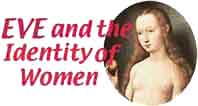
 Eve and the Identity of Women Eve and the Identity of Women
 St. Augustine's Penis and Original Sin St. Augustine's Penis and Original Sin
 The Power of Women The Power of Women
The Sacred Feminine
Mary Magdalen, even as she appears in the scriptures, is akin, as Marjorie Malvern has argued (Venus in Sackcloth: The Magdalen's Origins and Metamorphosis, 1975), to ancient female fertility figures and regenerative goddesses. In her may be identified aspects of the Great Goddess, of Isis, of Venus, of Eve, of Psyche, and Pandora.
Mary Magdalen may be recognized as a figure of very ancient, pre-Christian origin. Her most conspicuous symbol, the ointment jar or pot, is an especially potent symbol, and one which we recognize as belonging also to Psyche and to Pandora. Its association with the ancient mythic female principle is perhaps one of the clues to the enduring appeal of Mary Magdalen.
In many ways, Mary Magdalen is the most accessible of the female saints, a real human being, unlike the lofty, remote and far too pure and unreal Virgin Mary. Part of her appeal, to be sure, resides in her embodying a fundamental female identity, which may be very ancient. Her principal attribute is the ointment pot or jar. The vessel, however, can also appear as a vase or a monstrance.
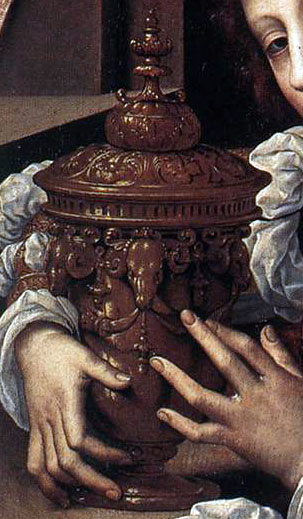
|
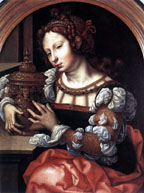
Jan Mabuse (Jan Gossaert)
Woman Portrayed as Mary Magdalen
c. 1520
(Museum Mayer van den Bergh, Antwerp)
|
An ancient Neo-Sumerian statue shows a woman, perhaps a goddess, holding a jar, or a vase, or a chalice, out of which flows water. Held at waist-level, the vessel appears symbolic of the female vagina and thereby also a metaphor for female sexuality and power.
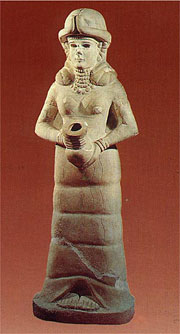
Standing female figure with a vase. Neo-Sumerian (c. 1800 BCE), from Mari.
The image of Mary Magdalen removing the lid of the vessel is an especially potent symbol.
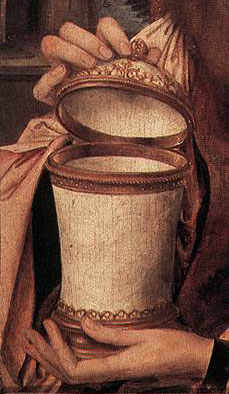
|
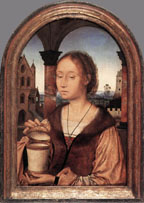
Quentin Metsys
Mary Magdalen
c. 1520 ?
(Koninklijk Museum voor Schone Kunsten, Antwerp)
|
The action of removing the lid we recognize as belonging also to Psyche and Pandora.
Its association with the ancient mythic female principle is perhaps one of the clues to the enduring appeal of Mary Magdalen; and it is also the unacknowledged motif around which have been shaped the various myths and legends that have been attached to this woman over the centuries.
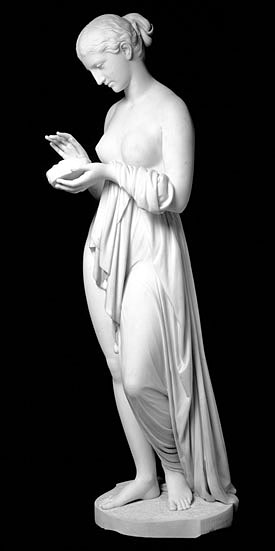
Chauncey B. Ives, Pandora, 1858 (Huntington Library, San Marino, California)

Anonymous, Mary Magdalen Bourbonais, late 15th century, Church of Saint-Pierre, Montlucon
The jar, vase, pot, or chalice, is the source of life, but also the source of evil for men.

Jean Cousin, Eve Prima Pandora, c. 1550 (Musée du Louvre, Paris)
The figure in Jean Cousin's painting was based upon a now-lost image of Mary Magdalen. Eve/Pandora/Mary Magdalen reclines nude with one hand on a skull, the other on her jar. A snake, an ancient symbol of the Goddess, entwines her left arm in the way one sees in images of Isis.
The garbled Biblical account of a female follower of Christ barely conceals to the perceptive eye a woman of immense importance.
|

